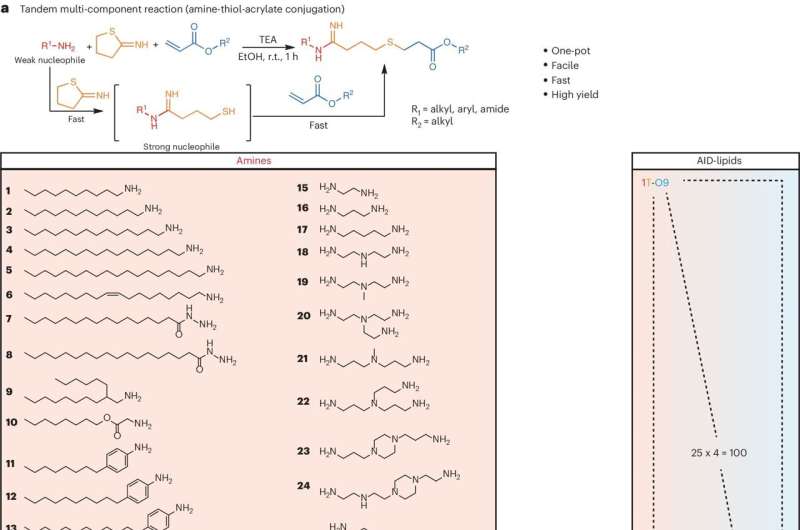
Imagine a scenario where a skilled hacker must upload critical software to update a central server and thwart a potentially lethal virus from wreaking havoc across a vast computer network. The programmer, armed with the lifesaving code, must navigate through treacherous territory teeming with adversaries, and success hinges on promptly getting a safe, stealthy delivery vehicle that can place the hacker exactly where they need to be.
In the context of modern medicine, messenger RNA (mRNA) serves as the hacker, carrying genetic instructions to produce specific proteins within cells that can induce desired immune responses or sequester maladaptive cellular elements. Lipid nanoparticles (LNPs) are the stealthy delivery vehicles that transport these fragile mRNA molecules through the bloodstream to their target cells, overcoming the body’s defenses to deliver their payload safely and efficiently.
However, much like building an advanced stealth vehicle, the synthesis of cationic lipids—a type of lipid molecule that’s positively charged and a key component of LNPs—is often a time-consuming process, involving multiple steps of chemical synthesis and purification.
Now, Michael Mitchell and a team at the University of Pennsylvania have addressed this challenge with a novel approach that leverages a compound library fabrication technique known as “click-like chemistry” to create LNPs in a single, simple step. Their findings, published in the journal Nature Chemistry, show that this method not only speeds up the synthesis process but also presents a way to equip these delivery vehicles with a “GPS” to better target specific organs such as the liver, lungs, and spleen, potentially opening new avenues for treating a range of diseases that arise in these organs.
“We’ve developed what we call an amidine-incorporated degradable (AID) lipid, a uniquely structured biodegradable molecule,” Mitchell says. “Think of it as an easy-to-build custom mRNA vehicle with a body kit that informs its navigation system. By adjusting its shape and degradability, we can enhance mRNA delivery into cells in a safe manner. By adjusting the amount of the AID lipid that we incorporate into the LNP, we can also guide it to different organs in the body, much like programming different destinations into a GPS.”
First author Xuexiang Han, a former postdoctoral researcher in the Mitchell Lab, explains that their new approach allows the rapid creation of diverse lipid structures in just an hour, compared to the weeks-long process traditionally required.
“The result is a significant acceleration in the development and testing of AID-lipids,” he says. “This will enable us to explore a broader range of lipid compositions and their effects on mRNA delivery.”

To achieve these accelerated AID-lipid builds, the researchers made use of a tandem multicomponent reaction (T-MCR) to synthesize the AID-lipids, a process that involves combining chemical compounds––an amine, thiol, and acrylate––in a single step to produce diverse lipid structures rapidly. The one-pot synthesis approach significantly reduces the time needed to produce cationic lipids, making it a more efficient and scalable solution for mRNA-LNP delivery.
Mitchell’s team synthesized 100 different AID-lipids, which were then formulated into LNPs. The resulting LNPs were tested for their ability to deliver mRNA to various organs in animal models, which showed the team they could target specific organs with high precision.
A key feature of these AID-lipids is their ability to incorporate degradable components, ensuring that the LNPs break down safely within the body after delivering their mRNA payload. This biodegradability is essential for minimizing potential side effects and ensuring that the therapeutic agents do not accumulate in the body over time. The researchers demonstrated that the AID-lipid LNPs could effectively deliver mRNA encoding functional proteins, highlighting their potential for use in a wide range of therapeutic applications.
Another significant finding was the identification of a distinct head (or tail) ring-alkyl aniline structure that proved particularly effective in enhancing mRNA delivery. This structure, which the team dubbed the “wedge effect,” enables the LNPs to penetrate cellular membranes more efficiently, facilitating the release of mRNA into the target cells. The study showed that LNPs with this structure achieved higher transfection efficiencies and greater protein expression levels compared to LNPs without this structure.
The researchers also explored the potential of AID-lipid LNPs to deliver mRNA vaccines targeting specific immune cells and demonstrated that these LNPs could selectively transfect antigen-presenting cells in the spleen, a critical step for inducing robust immune responses.
“This finding opens up new possibilities for developing mRNA-based vaccines that can precisely target and activate the immune system, potentially leading to more effective and long-lasting immunity against various diseases,” Han says.
As Mitchell and the team continue to refine their platform, they are focusing on even more precise targeting, particularly in the lungs.
“We’re now working on guiding our vehicles past the initial barrier of blood vessels to reach deeper into lung tissue,” Mitchell says. “It’s a bit like programming our delivery system to navigate through increasingly complex security layers.”

